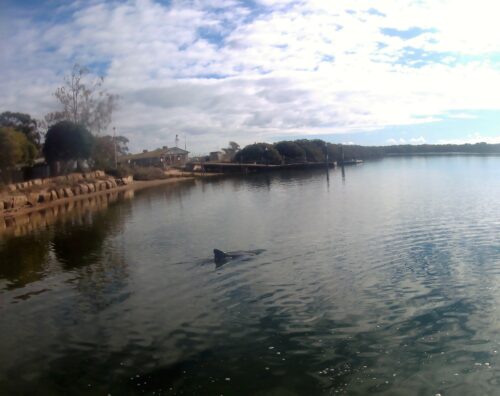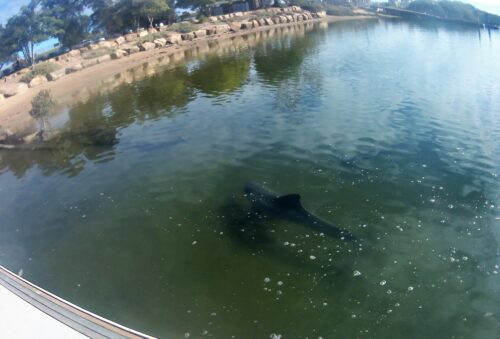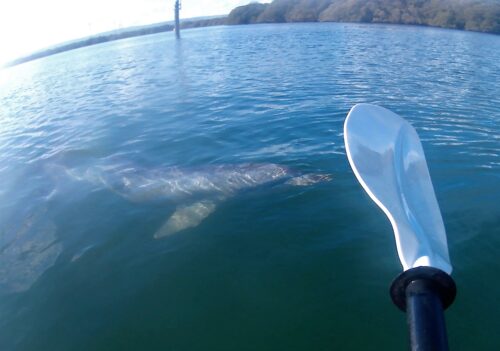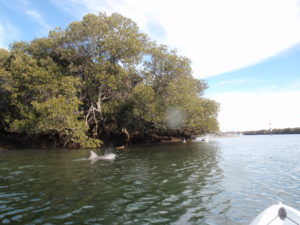On 15th November, I attended a community forum held by the Australian Marine Wildlife Research & Rescue Organisation Inc. (AMWRRO) to discuss recent (& ongoing) dolphin deaths in the Port River. I was pleased to be able to ‘get the ball rolling’ at the forum by detailing what the Marine Life Society of SA knew about the Adelaide Dolphin Sanctuary and the Port River.
I followed up on the results of the forum by reporting to our General Meeting two nights later. Our members agreed that our Society should get involved in lobbying for the welfare of the dolphins and an improved Adelaide Dolphin Sanctuary Act.

I have tried to document some of the Facebook conversations about the topic below: –
I soon posted on our Facebook page that “The Adelaide Dolphin Sanctuary Act needs a thorough review if the few remaining resident dolphins in the sanctuary are to survive and flourish.”
I followed this up by later posting, “The ADS Act (South Australia Adelaide Dolphin Sanctuary Act 2005) does little to protect the dolphins. It needs to be amended to ensure that the dolphins get the care and attention that they need and deserve. The Act is due to be reviewed in 2022. If you care for the Port River dolphins, please lobby the Government to tidy up the ADS Act and reverse the current trends. Meanwhile, if you find an injured animal, call AMWRRO on (08) 8262 5452.”
One friend soon commented, “Thank you for raising awareness about this. Keep up the great work.” Another friend soon provided the following information: –
“I have personally found two juvenile dolphins deceased. One was at the Birkenhead Tavern Port Adelaide with a deadly Kingfish lure swallowed. The second victim was located at Garden Island entangled in blue and yellow rope.”
I replied with the suggestion that these incidents were “fishing tackle & waste or litter problems”. My friend responded, “mainly fishing tackle problems. I have a large collection of lures taken from the Birkenhead Tavern section i.e. around 300! The large Kingfish lures are particularly dangerous to young dolphins. I have spoken to Dr Mike Bossley concerning the entanglement of old Telstra rope. Recently I removed another entanglement device created from quality white rope located at the Folklore Cafe. This rope was adorned with celery and other similar vegetables! What, what, what are people doing?”
I soon made another Facebook post saying, “A listing of some of the contributors to dolphin deaths in the Port River: Pollution, litter, dredging, illegal fishing practices, fishing debris, boating, racing, insufficient testing, insufficient treatment.”
One friend soon responded, “Pollution ✔️✔️, I’d love to test a few outlets along there.” My response was, “There are creeks, industry and outfalls that could all carry pollution into the sanctuary.” My friend replied, “Yes I agree. While whole of system is important, I’d be homing in on 5- 6 locations of point source contaminant dispersal.” I said “Thanks,” to my friend, “please report back to us.”
One of our members commented, “We need more law enforcement patrols and smart monitoring (cameras, sensors, etc) …”
A friend posted, “The resident dolphin population in the Port Adelaide River appears to be down to just six animals.” Another friend responded, “Depends how you define “resident” and “Port River”. My estimate would be about 20 seen on 20% of surveys for the Port River/Barker Inlet system. Over the past three years there has been about a 30% reduction in the number of dolphins sighted during routine surveys. Research by veterinary pathologists and dolphin scientists is underway to try and determine the cause(s) of this apparent decline. At this stage the best guess is that a toxin of some sort is impacting their immune systems, making them susceptible to a variety of parasitic, viral, bacterial and fungal pathogens. We just have to hope that if a specific toxin is to blame that there is something that can be done to remove or denature it. …….”
Friends suggested issues such as “Anti-fouling paint washed into the river? Heavy metals mobilised from dredged sediment and powerplant effluent? Leaching from Wingfield tip? The ASC and associated industry? PFAS from firefighting drills? The issue for the St. Kilda mangroves?”
One friend agreed, saying “Yes, all of the above are potentially a culprit. Other potential sources include illegal dumping, leaching from Garden Island, storm water discharges, industrial effluent, etc. It is also possible there are natural toxins such as from dinoflagellates (red tides) or other “natural” toxins arising from ecological changes. The number of potential sources is very depressing.”

The following link for the State Government’s report “Adelaide Dolphin Sanctuary Investigation” was posted on Facebook by someone: – https://www.environment.sa.gov.au/topics/plants-and-animals/living-with-wildlife/whales-dolphins/adelaide-dolphin-sanctuary-investigation?fbclid=IwAR37u2L3v7Gmw0gWSzW7RMMEQOpvbOB77I1_7cJAjNOAyPLA9hetqICWPJQ
Some people started sharing details of letters that they had sent to the Premier, Government Ministers and Shadow Ministers.
One such letter called for PIRSA/SARDI to collect a variety of organisms across the marine food web, and spatially across the Port River estuary, and arrange for their analysis in order to identify, characterise and map contamination in the ecosystem.
It was suggested that contamination, hypersaline brine seepage, heat and chemical discharges, garbage and fishing debris were all threats to the dolphins. Concerns were also expressed about mobilised heavy metals from dredging works, groundwater and surface leaching from the rubbish dump at Wingfield, and disturbed contaminated soil from the Dock 1 and Fletcher Slip developments. Sampling for dinoflagellate blooms was also suggested.
I have also been following newspaper reports in The Advertiser, including Letters to the Editor. One report quoted the Department for Environment and Water interim report on an investigation into the dolphin deaths as follows: –
“(The) level of toxic contaminants I dolphins from some areas of SA are unacceptably high ….. The extent to which these could be impacting the health of the dolphins is being explored through these studies.”
A letter to the editor suggested that we “make sure we don’t add any more industrial operations that would further impact the Adelaide Dolphin Sanctuary”. It went on to say, “Falling in to that category is Venice Energy’s proposed gas-import terminal and regasification plant at Pelican Point. Apart from the terrible dredging and pile-driving this project would entail, the plan itself to import gas from overseas to SA is a totally unnecessary dud.”

That is the situation to date. As I said earlier on, “The ADS Act (South Australia Adelaide Dolphin Sanctuary Act 2005) does little to protect the dolphins. It needs to be amended to ensure that the dolphins get the care and attention that they need and deserve. The Act is due to be reviewed in 2022. If you care for the Port River dolphins, please lobby the Government to tidy up the ADS Act and reverse the current trends.”


Good content across many informants and covering just about every possible factor contributing to dolphin decline in their once healthy habitat.
FWIW I see similarities between the recent and seemingly quite rapidly escalating decline in Port River dolphin numbers and the continuing extinction trend in the bushland birds of Adelaide and the Mount Lofty Ranges.
Ornithologists have been saying for decades that the many smaller, specialised birds( such as robins flycatchers tree-creepers and my favourite, the now locally extinct Azure Kingfisher) on the long list of species in decline or recently declared as locally extinct were always going to continue to decline and in many cases become locally extinct, because it takes many decades after habitat loss and fragmentation of small populations in remnant vegetation and conservation parks before a vulnerable species goes from ‘frequently seen by early settlers ‘ to ‘ hardly seen these days ‘ to ‘not seen for several decades so probably locally extinct ‘.Habitat loss(vegetation clearance for agricultural purposes) and habitat degradation (weed incursions, increased predation by foxes cats and rats, nesting hollows occupied by European honey bees, phytophora fungal root disease, and changes in aquifer water supply and quality, to name a few) are the key drivers of this avian decline on our doorstep. But once the habitat has become insufficient, there is a lag of many decades before such birds become extinct.
I’m not saying that mangroves and saltmarshes were decimated by broadacre clearance (chains, bulldozers, ringbarking,axing etc) in the Port Adelaide area to the same extent that occurred on the Adelaide Plains and in the Mount Lofty Ranges (90% of the original vegetation of the Fleurieu Peninsula was cleared for farming, and if you exclude areas under formal protection eg Deep Creek CP, the figure is 98% clearance for private and public land!).
But the other key driver, habitat degradation, has certainly been occurring-often insidiously – for many, many decades in the Port River region (eg the number of established ,recognised feral marine species continues to grow decades after international legislation was enacted to prevent dumping of ballast water from container ships anywhere on the continental shelf waters globally, which till then was undoubtedly the greatest single source of invasive marine species in most countries with open coastlines.
This estuarine habitat degradation- due nutrient excess, point discharge of industrial toxins, anthropogenic changes in water temperature from cooling systems for power generation, dredging and all the other factors Steve has covered in this article- began very early in the post European invasion era.
And now the sins of the fathers are being visited upon the sons.
And one question in my mind and doubtless many people’s is: Will the decline and potential local extinction of this pod have a flowon effect on the more numerous dolphins of the same species that inhabit greater metropolitan Adelaide’s coastal waters?
The answer would have to be:” very likely “. Almost irrespective of whether one particular cause of death for most of the Port River dolphins is identified by necropsy and other relevant forensics.
Because the greater Adelaide metropolitan coast is also under seige from the same or equivalent factors.
And has been long before we’d even heard about global warming and climate change.